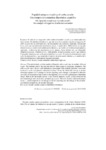Mostrar o rexistro simple do ítem
Español antiguo recudir y el verbo acudir. Un ejemplo de semántica diacrónica cognitiva
| dc.contributor.author | Santano Moreno, Julián | |
| dc.date.accessioned | 2021-05-13T11:05:30Z | |
| dc.date.available | 2021-05-13T11:05:30Z | |
| dc.date.issued | 2021-01-30 | |
| dc.identifier.citation | Santano Moreno, J. (2021). Español antiguo recudir y el verbo acudir. Un ejemplo de semántica diacrónica cognitiva. Revista de Lexicografía, 26, 131-158. https://doi.org/10.17979/rlex.2020.26.0.7100 | es_ES |
| dc.identifier.issn | 2603-6673 | |
| dc.identifier.issn | 1134-4539 | |
| dc.identifier.uri | http://hdl.handle.net/2183/27928 | |
| dc.description.abstract | [Resumen] El artículo se ocupa del verbo medieval español recudir y su continuador moderno acudir. El método utilizado es el que deriva de la semántica diacrónica cognitiva. El verbo recudir era un verbo deíctico y de movimiento con dirección implicada, movimiento hacia atrás con una dimensión prospectiva detrás. A partir del s. XIII aparece un segundo prototipo con un cambio en la señalización deíctica y un cambio en la dirección prospectiva implicada: la dirección del movimiento es la opuesta, hacia delante con una dimensión prospectiva delante. También el s. XIII aparece un nuevo lexema, acudir, que continúa el segundo prototipo y que acaba por reemplazar recudir. El nuevo lexema presenta como sufijo la preposición a-, que responde al cambio de señalización deíctica y al cambio de la dirección prospectiva implicada del segundo prototipo. | es_ES |
| dc.description.abstract | [Abstract] The article deals with the medieval Spanish verb recudir and its modern follower acudir. The method used is the one that derives from cognitive diachronic semantics. The verb recudir was a deictic verb indicating a movement with implied direction, movement backwards with a prospective dimension behind. From the thirteenth century a second prototype appears with a change in deictic signaling and a change in prospective direction involved: the direction of movement is the opposite, forward with a prospective dimension ahead. Also in the thirteenth century a new lexeme appears, acudir, which continues the second prototype and which ends up replacing recudir. The new lexeme suffixes the preposition a-, which responds to the change in deictic signaling and the change in the prospective direction implied by the second prototype. | es_ES |
| dc.language.iso | spa | es_ES |
| dc.publisher | Universidade da Coruña | es_ES |
| dc.relation.uri | https://doi.org/10.17979/rlex.2020.26.0.7100 | es_ES |
| dc.rights | Atribución-NoComercial-CompartirIgual 4.0 Internacional (CC BY-NC-SA 4.0) | es_ES |
| dc.rights.uri | https://creativecommons.org/licenses/by-nc-sa/4.0 | |
| dc.subject | Recudir | es_ES |
| dc.subject | Acudir | es_ES |
| dc.subject | Semántica diacrónica cognitiva | es_ES |
| dc.subject | Cognitive diachronic semantics | es_ES |
| dc.title | Español antiguo recudir y el verbo acudir. Un ejemplo de semántica diacrónica cognitiva | es_ES |
| dc.title.alternative | Old Spanish Recudir and the Verb Acudir. An Example of Cognitive Diachronic Semantics | es_ES |
| dc.type | info:eu-repo/semantics/article | es_ES |
| dc.rights.access | info:eu-repo/semantics/openAccess | es_ES |
| dc.date.updated | 2021-05-13T10:02:49Z | |
| UDC.journalTitle | Revista de Lexicografía | es_ES |
| UDC.volume | 26 (2020) | es_ES |
| UDC.startPage | 131 | es_ES |
| UDC.endPage | 158 | es_ES |
| dc.identifier.doi | 10.17979/rlex.2020.26.0.7100 |






